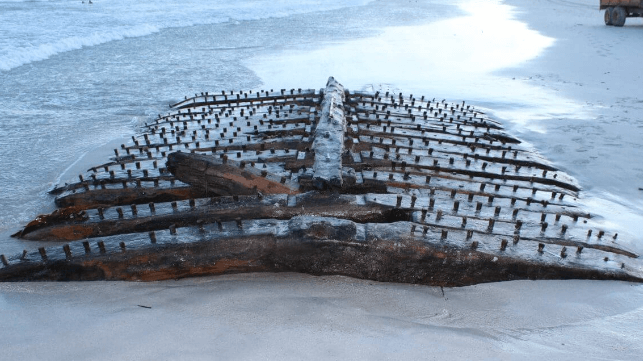Researchers Identify Wreck of Revolutionary War-Era British Frigate

The wooden sailing vessel uncovered on the shores of the Orkney Islands last year has been identified as a Royal Navy frigate that played a small role in the American Revolutionary War.
The wreck was discovered on a sandy beach at the northeast end of Sanday, one of the northernmost islands in the Orkneys. Shifting wind and wave patterns removed the sand that had covered the remains of the ship for centuries. Local residents helped drag the surviving timbers off the sand with tractors, and professional archaeologists went about the task of preserving and examining the recovered wreckage.
Hundreds of wrecks have gone down around the storm-wracked Orkneys, and it took time to narrow down just which ship this one might be. Wessex Archaeology was given the task of the analysis. Based on the tree rings in the wood, the team determined that the ship was built in the mid-1700s. By process of elimination, the team narrowed it down to the HMS Hind, a sixth-rate Royal Navy frigate built in 1749.
Hind departed England for North America in 1758 during the Seven Years' War, and participated in the siege of French forces at Louisburg, Nova Scotia that summer. She continued throughout the campaign to remove French influence in the region, including the successful capture of Quebec the following year. During the Revolutionary War, she served as a convoy escort for British ships, the researchers found. After returning to the British Isles, she was converted to a transport ship, then sold into private hands in 1784.
Renamed Earl of Chatham, the former frigate became a whaler in the North Atlantic trade, one of more than 100 whaling ships based out of London - a primary hub for the whale oil and whalebone trade in the late 1700s. The former frigate only lasted a year as a whaler: it wrecked in foul weather off of Sanday in 1785. Luckily, all crewmembers survived the ordeal.
For now, the wooden wreckage has been placed in freshwater tanks at the Sanday Heritage Centre while the project sponsors consider a permanent solution, according to ABC. The National Heritage Memorial Fund (NHMF) and Historic Environment Scotland provided funding for the project.
